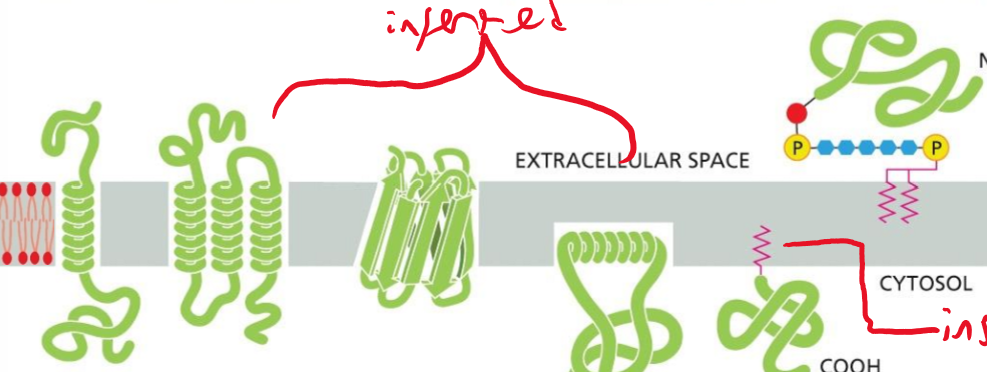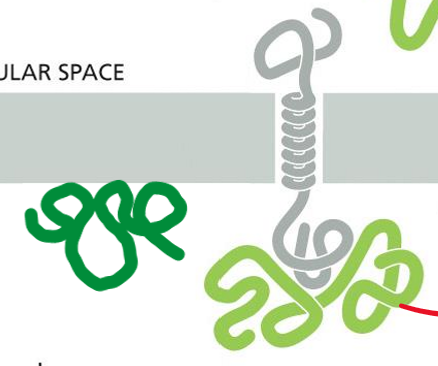BIO130 - Week 7 Lecture + Textbook
1/57
There's no tags or description
Looks like no tags are added yet.
Name | Mastery | Learn | Test | Matching | Spaced |
|---|
No study sessions yet.
58 Terms
The specialized material outside of the cell
Found only in animal cells
What is the Extracellular Matrix? In what organisms is it found?
An organelle that manages the degradation of unnecessary cellular components
What is a Lysosome? In what organisms is it found?
The wall surrounding the cell, protecting against mechanical stress and providing the cell with its shape
Found in plant cells only
What is the Cell Wall? In what organisms is it found?
‘Sacs’ - 2 types
Degradation (similar function to animal lysosome)
Storage (small molecules, proteins)
Found in non-animal cells
What is the Vacuole? In what organisms is it found?
The organelle at which photosynthesis occurs
Not found in animal cells
What is the Chloroplast? In what organisms is it not found?
Cytoplasm: The contents of the cell outside of the nucleus, including the cytosol
Cytosol: The aqueous part of the cytoplasm
Lumen: The inside of organelles
Lumen + cytosol = cytoplasm!
Distinguish between the Cytoplasm, Cytosol, and Lumen in eukaryotes
Compartmentalization
Scaffolding for biochemical activities
Selectively permeable barrier
Transportation of solutes
Response to external signals
Intercellular interactions
What are some functions that occur at cellular membranes in eukaryotic cells?
A two-layer (or ‘leaflet’) sheet of amphipathic phospholipids and proteins
What is a Membrane Bilayer?
Hydrophilic/polar ‘head’ group, facing water
Hydrophobic tails, ‘tucked away’ into the inner part of the bilayer
What two parts make up a phospholipid?
Phospholipids, Sterols, Glycolipids
What are the different kinds of lipids found in membranes?
A specific type of lipid containing a phosphate group within the polar head
Many contain a glycerol group, giving them the name phosphoglycerides
Structure:
<Various groups>
Phosphate
Glycerol
Hydrocarbon tails
Explain the structure of phospholipids - What are their defining features? What is the overall structure?
A phospholipid with a phosphate group attached to a glycerol
The glycerol then connects the two hydrocarbon tails
What is a phosphoglyceride?
14-24 carbon atoms long
Typically have one saturated (all C-C bonds), one unsaturated (cis C=C bond, forming a ‘kink’) tail
Explain the features of the phospholipid hydrocarbon tails.
Most energetically favourable arrangement
Polar head group interacts with water (favourable)
Hydrophobic hydrocarbon tails interact with other hydrocarbon tails (favourable)
Why do phospholipids spontaneously self-associate into a layer in an aqueous environment?
More energetically favourable - in a planar bilayer, hydrophobic tails will be exposed to water along the edges
This does not occur in a sealed compartment, shielding the tails from water
Why do phospholipid bilayers assemble into sealed compartments?
An artificially created lipid bilayer, used to study lipid properties, membrane protein properties, and drug delivery into cells
Closed, sphericle vesicle of pure phospholipids - always artificial
What is a Liposome?
No, they are fluid and can be deformed without damaging
Are cell membranes solid?
Lipids, within each leaflet, can
Diffuse laterally (sideways movement)
Rotate (rotate horizontally)
Flex (flex hc tails)
Phospholipids can move between layers (flip-flop), but do so rarely due to energetic unfavourability
Exposure of hydrophobic to water
How can phospholipids move? Explain.
No, it is carefully regulated as it is important for function (i.e. membrane proteins used for transport, signaling, etc.)
Rigidity would inhibit function, but so would lack of regulation
Is cell membrane fluidity freeform and unregulated? Why or why not?
Temperature (lower temp → less fluid, more viscous)
Phospholipid saturation (more unsaturated hc chains → increase fluidity, reduce tight packing) at lower temperatures
Tail length (shorter tails → less interaction, more fluid) at lower temperatures
Lipid composition (addition of cholesterol → stiffens membrane, lowers permeability)
What factors can affect membrane fluidity? How so?
Animal: primarily Cholesterol
Plant: More versatile plant sterols, some cholesterol
What is the most frequently seen cholesterol in animal cells? What about Plant cells?
Decreases mobility of phospholipid tails by inserting itself and stiffening membrane
Decreases permeability of polar molecules, allowing more control over entry
What is the maximum ratio of cholesterol and phospholipids? What is the affect of adding more phospholipids?
Scramblase
Catalyzes the rapid flip-flop of random phospholipids between leaflets
Necessary due to phospholypid synthesis in the cytosolic leaflet of the ER, which causes asymmetry unless random phospholipid flip flop occurs
What enzyme catalyzes the movement of phospholipids between leaflets? What are the properties of this switch? Why is this needed?
False - a given face will always remain on the same side as it travels (i.e. a protein on a cytosolic face will always be facing the cytosol)
T/F: Membranes switch orientation as they move between organelles
Enzymes in the Golgi membrane flipping lipids between leaflets
Flippase
Catalyzes the rapid flip-flop of specific phospholipids to the cytosolic leaflet
No flippase that can move cytosolic → lumen, only the other way around
Some types of lipids can bind cytosolic proteins at the plasma membrane
How does asymmetry in the lipid bilayer occur?
Proteins and lipids with sugars added on the luminal face of the golgi
What is a Glycolipid/Glycoprotein?
Typically end up on the noncytosolic face of the plasma (external) membrane or the inside of some organelles
Protect the membrane from harsh environments (e.g. high pH)
Where do glycoproteins/lipids typically end up? What is their function?
Transmembrane
Monolayer-Associated
Lipid-Linked
Protein-Attached
What are the four kinds of membrane proteins?

A membrane protein directly attached to the lipid bilayer
Transmembrane, Monolayer-associated, Lipid-linked
Can be inserted into a bilayer themselves, or attached to a lipid inserted into the bilayer
What is an Integral Membrane Protein? What are the types of proteins in this category? How are they extracted from the bilayer?

Proteins that do not directly insert into the membrane
Typically bound to other proteins or to lipids by non-covalent interactions
Gentle extraction methods which leave the lipid bilayer intact are used
What is a Peripheral Membrane Protein? How are they extracted?
Amphipathic proteins that cross the entire membrane and emerge out of either side
Have both hydrophilic domains within the aqueous outside (AA side chains are polar) and hydrophobic domains within the membrane (non-polar AA)
Explain the domains of transmembrane proteins
Single-pass alpha helix
Alpha helix passing vertically through the phospholipid layer
Multipass alpha helix
Multiple alpha helices arranged such that the hydrophilic side chains form an aqueous pore
Rolled beta sheet (Beta-barrel)
Meshwork, open channel made of beta sheets
What are the three types of Transmembrane proteins?
~20 hydrophobic amino acid side chains
What is the typical length of a membrane spanning alpha helix?
X-Ray Crystallography
Hydrophobicity Plots
What are the ways in which transmembrane protein structures are identified?
Determination of a protein’s 3-D structure
An X-ray is shined onto a protein crystal, getting a unique diffraction pattern - using this pattern, the structure is calculated
Explain X-Ray Crystallography.
Segments of 20-30 hydrophobic amino acids can span the lipid bilayer as an alpha helix
By observing a protein’s AA composition, we can measure each amino acids hydropathy index.
Small, sharp points of +delta G will likely be the amino acids within a hydrophobic domain
The number of these sharp regions is the umber of alpha helices (single/multipass)
Explain Hydrophobicity plots
Attached to cytosolic face by an amphipathic alpha helix (part of helix is exposed to aqueous cytosol, part is not)
Example: Proteins used in bending membranes to form vesicles at the ER make use of MAMP
What side are Monolayer-Associated Membrane Proteins attached? What are some examples of this?
Two types:
A protein with a GPI anchor
Synthesized on ER lumen, ends up on noncytosolic face of cell surface
Protein with a non-GPI lipid anchor (i.e. fatty acids0
Anchor added by cytosolic enzymes
Protein is directed to a cytosolic face
What is a Lipid-Linked Membrane Protein? What are the two types of this? Where do they end up?
A detergent is added to a membrane with a protein
The amphipathic detergent monomers form large ‘micelle' spheres reversibly
In doing this in the presence of the membrane, it splits the protein and lipid into micelle groups
Explain the process of extracting membrane proteins using detergent
Detergent micelles + monomers are added to a cell membrane, solubizing the proteins and lipid into separate groups
The protein of interest is purified from the rest of the solution
The detergent-phospholipid micelles are added to the protein, and the detergent micelles + monomers are removed
A new, artificial bilayer is formed, and the protein is incorporated
List the process for transferring proteins into an artificial bilayer
F.R.A.P
Fluorescence Recovery After Photobleaching
How can lateral diffusion/study of protein movement be measured in membranes?
Protein of interest is fused to G.F.P (Green Fluorescent Protein)
An area of the cell is photobleached to white
The rate of colour recovery can be used to estimate the rate of diffusion in a cell
Recovery comes from neighbouring, unbleached proteins randomly moving around and diffusign into the area
Explain Lateral Diffusion of Membrane Proteins
The time taken for neighbouring, unbleached proteins to move into a bleached area
Can go to full, or not
What is the Rate of Fluorescence Recovery?
Yes, via tight junctions
Called Membrane Domains
Can membrane protein movement be inhibited? What are the ranges of uninhibited movement called?
A protein-studded film, invisible to light microscopes
Protein bilayer
Selective channels
Define a Plasma Membrane
Bacteria: 1 (external)
Eukaryotes: Multiple, external + internal membranes
Enclose cell, ER, Golgi, endosomes, mitochondria
How many plasma membranes do bacteria have? Eukaryotes?
Organic solvents - insoluble in water
What are lipids soluble in?
Amphipathic
What is the most common property of membrane lipids?
An abundant phospholipid - choline attached to a phosphate group as a hydrophilic head
What is Phosphatidylcholine?
~25 nm
What is the minimum diameter of a vesicle?
~20% by weight on average
What percent of a plasma membrane is made up of cholesterol in animal cells?
Allows membrane proteins to rapidly diffuse and interact
Permits membrane lipids and proteins to diffuse from site of insertion to other regions
Ensures even distribution of membrane during division
Allows fusion of membranes
What other reasons is fluidity important in a cell?
Cytosolic surface of ER
Where are phospholipids manufactured in eukaryotes?
Golgi apparatus, with the flippases
Where does asymmetry first arise in the membrane?
Cytosolic monolayer, noncytosolic monolayer
What are the two lipids of the bilayer?
50%
What percentage, by mass, of an animal cell membrane is proteins?
Small, lipid-like, often cone-shaped molecule with one hydrophobic tail
What is the typical shape of detergent molecules?